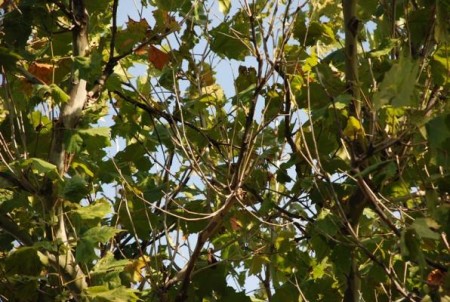I have a number of pictures taken in the Fall of 2010 in Detroit, MI on a site with 92 mature sycamore trees. Most of these trees are between 20″ and 35″ in diameter. Anthracnose has obviously been on this site, affecting these trees for many years. Some of the trees are declining to the point where the Cooperative that owns them was nearly ready to consider their removal. After contacting me and learning more about what I can do to save these trees, they have decided to start a gradual multi-year program to rid these trees of the disease. At the same time, we will be working on improving their overall health.
To start with, let’s show a picture of a sycamore tree on an adjacent site in Detroit that looks unaffected at this point from Anthracnose.
The sycamore tree on the left appears to be relatively unaffected by the Anthracnose disease, even though other trees in the area have been struggling for years. This is quite commonly found and can be explained with the thought: not everyone exposed to a cold virus catches a cold, while some people that catch a cold get much sicker than others. Once we get our sycamore trees back to good health, it is important to keep them adequately watered and fertilized over the course of a growing season. Just as all of us should get plenty of rest, drink fluids, and eat properly to maintain our health. Sycamore trees that are stressed are more susceptible to catching Anthracnose and other pathogens.
Now in this next picture, we start seeing the tell-tale signs of chronic Anthracnose. You won’t see the real problem until you click on this picture and look at the close-up. There, you will see that this tree is not at all as healthy as it appears at first glance. There are a lot of little groups of small branches that the leaves have fallen off of, and the tree is much thinner than the original, healthy sycamore tree. The disease starts as a brown lesion on the veins of the leaves, spreading and crinkling the leaf up, eventually causing it to fall off the tree.

In addition, many smaller twigs, visible here, are dying. Sometimes in the spring, you can get a sudden leaf and twig drop, causing most people to be concerned. But in a short time, the tree starts re-leafing and can look quite normal by June or mid-July. However, then the defoliation re-occurs, sometimes in the same season or sometimes in the following season. This repeated defoliation and re-leafing stresses the tree significantly by lowering stored sugar reserves, subjecting the tree to other damaging problems.

What becomes visible on the tree after these repeated cycles is a growth deformity we refer to as “witches’ broom.” The repeated defoliation and re-leafing keeps happening from the same location, giving the appearance of a broom in various little clumps all over the tree. The overall health of the tree is declining and this new deformed growth is unattractive.
While the tree may survive for a few years with this reoccurring problem, this next picture shows what starts to happen to our sycamore trees. The “witches’ broom” look get very pronounced. This deformed growth starts looking terrible and the leaf and twig drop gets even worse. Then what happens is the discussion about removing these trees, as most people do not realize this problem is controllable and reversible. You need to have a two pronged approach to solving this problem. 1) Treat the disease; and 2) increase the overall health of the tree by encouraging the tree to replenish its long-depleted sugar reserves. This usually takes two years.
If you are having problems with your sycamore trees and the Anthracnose disease, contact me! Wouldn’t you love to have your old tree back and stop the massive clean-up in your yard each year? You need a Board Certified Master Arborist that knows how to deal with your tree problems. If you would like more information you can go to the Sycamore Anthracnose section of this website, or you can send us an email at emeraldtreecarellc@gmail.com or call us at 630-480-4090.


